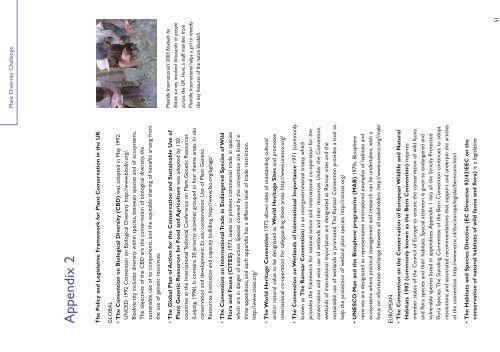Plant Diversity Challenge - Plantlife
Plant Diversity Challenge - Plantlife
Plant Diversity Challenge - Plantlife
You also want an ePaper? Increase the reach of your titles
YUMPU automatically turns print PDFs into web optimized ePapers that Google loves.
Appendix 2The Policy and Legislative Framework for <strong>Plant</strong> Conservation in the UK<strong>Plant</strong> <strong>Diversity</strong> <strong>Challenge</strong>GLOBAL• The Convention on Biological <strong>Diversity</strong> (CBD) was adopted in May 1992.UNCED 1992 Convention on Biological <strong>Diversity</strong> http://www.biodiv.org/.Biodiversity includes diversity within species, between species and of ecosystems.The objectives of the CBD are the conservation of biological diversity, thesustainable use of its components, and the equitable sharing of benefits arising fromthe use of genetic resources.• The Global Plan of Action for the Conservation and Sustainable Use of<strong>Plant</strong> Genetic Resources for Food and Agriculture was adopted by 150countries at the International Technical Conference on <strong>Plant</strong> Genetic Resources(Leipzig, 1996). It contains 20 priority activities grouped in four theme areas: In situconservation and development; Ex situ conservation; Use of <strong>Plant</strong> GeneticResources; Institution and capacity builiding. http://www.fao.org/ag/agp/• The Convention on International Trade in Endangered Species of WildFlora and Fauna (CITES) 1973, seeks to prevent commercial trade in specieswhich are in danger of extinction. Species covered by the convention are listed inthree appendices, and each appendix has a different level of trade restriction.http://www.cites.org/<strong>Plant</strong>life International’s 2003 Bluebells forBritain survey involved thousands of peopleacross the UK. Here, a staff member from<strong>Plant</strong>life International helps a girl to identifythe key features of the native bluebell.• The World Heritage Convention 1972 allows sites of outstanding culturaland/or natural value to be designated as World Heritage Sites and promotesinternational co-operation for safeguarding these areas. http://www.unesco.org/• The Convention on Wetlands of International Importance 1971 (commonlyknown as The Ramsar Convention) is an intergovernmental treaty, whichprovides the framework for national action and international co-operation for theconservation and wise use of wetlands and their resources. Under the Convention,wetlands of international importance are designated as Ramsar sites and thesustainable use of wetlands is promoted.The Ramsar Convention provides a tool tohelp the protection of wetland plant species. http://ramsar.org/• UNESCO Man and the Biosphere programme (MAB) 1970s. Biospherereserves are designated as representative international examples of habitats andecosystems where practical management and research can be undertaken, with afocus on information exchange between all stakeholders. http://www.unesco.org//mab/EUROPEAN• The Convention on the Conservation of European Wildlife and NaturalHabitats 1982 (commonly known as the Bern Convention) requiresmember states of the Council of Europe to ensure the conservation of wild faunaand flora species and their habitats. Special attention is given to endangered andvulnerable species listed in appendices.Appendix 1 lists all the Strictly ProtectedFlora Species.The Standing Committee of the Bern Convention continues to adoptresolutions and associated recommendations that support and underpin the articlesof the convention. http://www.ecnc.nl/doc/europe/legislat/bernconv.html• The Habitats and Species Directive (EC Directive 92/43/EEC on theconservation of natural habitats of wild fauna and flora) is a legislative51
















